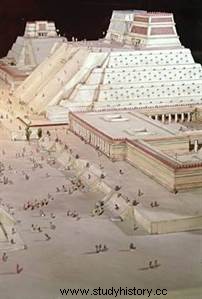 The Aztecs (or Mexicas) dominated southern and central Mexico from the 14th to the 16th century, building an empire there. and a brilliant civilization . The term “Aztec” comes from Aztlan , mythical homeland of northern Mexico meaning in Nawatl "White Land .” This term was popularized by historians like the Jesuit Francisco Javier Clavijero in his book La Historia Antigua from Mexico published in 1780. The Aztecs founded on the islands of the lake Texcoco the famous city Mexico-Tenochtitlan which exceeds in number of inhabitants the European capitals. They surprised the Europeans by the beauty of their city but especially by the recurrence of human sacrifices. The Spanish conquistador Hernan Cortès caused the fall of this empire in 1521.
The Aztecs (or Mexicas) dominated southern and central Mexico from the 14th to the 16th century, building an empire there. and a brilliant civilization . The term “Aztec” comes from Aztlan , mythical homeland of northern Mexico meaning in Nawatl "White Land .” This term was popularized by historians like the Jesuit Francisco Javier Clavijero in his book La Historia Antigua from Mexico published in 1780. The Aztecs founded on the islands of the lake Texcoco the famous city Mexico-Tenochtitlan which exceeds in number of inhabitants the European capitals. They surprised the Europeans by the beauty of their city but especially by the recurrence of human sacrifices. The Spanish conquistador Hernan Cortès caused the fall of this empire in 1521.
The origins of the Aztecs
The Aztecs inherited from the Toltecs , craftsmen who excel in the art of painting, sculpture and pictographic writing. The latter lived in the highlands of Mexico and founded the city of Tula in 980. The Toltec universe is made up of both nomads and sedentary people, as well as barbarians. They worship Quetzalcoatl, the feathered serpent god and were ruled by a priest of the same name until the 12th century. Following an internal fracture and rivalries, this priest flees to take refuge in the Yucatan. The empire eventually collapses and the Toltecs disperse.
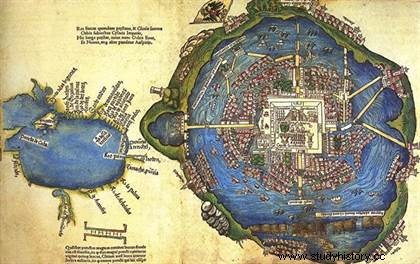 A tribe from the mysterious city of Azlan decides to migrate to the northern steppes to the fulfillment of the prophecy of Huitzilopochtli, God of the war. Prophecy that the migration of the people would end when they saw an eagle devouring a snake on a cactus. It finally took place in 1325 in the Valley of Mexico on an islet of Lake Texcoco, a rather inhospitable location because it was infested with vipers.
A tribe from the mysterious city of Azlan decides to migrate to the northern steppes to the fulfillment of the prophecy of Huitzilopochtli, God of the war. Prophecy that the migration of the people would end when they saw an eagle devouring a snake on a cactus. It finally took place in 1325 in the Valley of Mexico on an islet of Lake Texcoco, a rather inhospitable location because it was infested with vipers.
Tenochtitlan, capital of the Aztec Empire
The Aztec city named Mexico-Tenochtitlan was built in 1370 , and overlooks the Gulf of Mexico. It is so called in honor of the priest Tenoch, guide of the expedition. In 1375 Acamapichtli was the first Aztec ruler, probably of Toltec origin, embodying Quetzalcóatl. Subjugated by a regional power, the Aztec Empire eventually broke away from the tutelage of Azcapotzalco, thanks to the establishment of the Triple Covenant . The latter, made up of Tenochtitlan and the two allies:Texcoco and Tlacopan, broke the Tepanec power in 1428.
Due to its location and high level of organization, the city of Tenochtitlan thrives. At the time when the Spaniards began their conquests, in 1519, the large market of Tlatelolco (a city incorporated into the capital Tenochtitlan) attracted up to 60,000 people daily. Goods came into Aztec hands in payment of tribute from conquered territories, and many goods were exported from the city to be sold in other parts of the Aztec Empire and Central America.
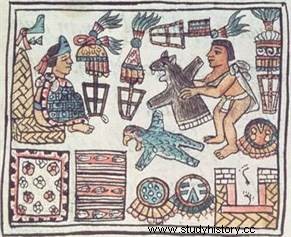 Several rulers follow one another, but it is under the reign of the Aztec rulers Moctezuma I from 1440 and Moctezuma II from 1502 that the Empire is gaining momentum. These sovereigns undertook numerous wars with the aim of extending the territory to the tropical provinces and subjecting the regions to tribute. It was Moctezuma I who instituted flower wars in order to overcome bad weather conditions by capturing enemies to sacrifice them and calm the anger of the Gods.
Several rulers follow one another, but it is under the reign of the Aztec rulers Moctezuma I from 1440 and Moctezuma II from 1502 that the Empire is gaining momentum. These sovereigns undertook numerous wars with the aim of extending the territory to the tropical provinces and subjecting the regions to tribute. It was Moctezuma I who instituted flower wars in order to overcome bad weather conditions by capturing enemies to sacrifice them and calm the anger of the Gods.
A religion focused on human sacrifice
The Aztecs are polytheists and consider themselves the chosen people of the Sun. According to the myth, the sun did not originally exist. These are the gods who, once gathered in Teotiwacan, sacrificed themselves to enlighten the world. In order to regenerate the cosmos, the Aztecs constantly renew the divine sacrifice to prevent the return of Darkness. The ceremony takes place at the top of the great temple on the sacrificial stone where a priest opens the chest to retrieve the victim's heart and bake it in a stone urn. The victims wear the clothes and ornaments of the chosen god. They can be prisoners captured during the flower wars, slaves or Aztecs supposed to embody the image of the god.
Sacrifices also have economic and political functions. They must ensure the regular return of rain to the crops, and maintain Aztec domination by physically eliminating prisoners of war. No pre-Columbian civilization practiced sacrifice as much as the Aztecs, who made it a real institution. These rites horrified the Spaniards, who as Catholics interpreted these sacrifices as a demonic perversion and not as a sacred act.
Aztec civilization:a prosperous and hierarchical society
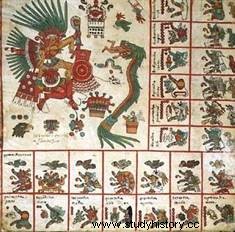 Mexico City Tenochtitlan is an extremelycrowded city , more than Paris at the time because it is home to between 500,000 and 1 million inhabitants. It consists of natural and artificial islets as well as a set of temples, palaces and gardens. Large aqueducts supply the city with drinking water. Intensive cultivation and the draining of swamps brought good yields and enriched the Empire. Merchants and craftsmen who are organized in corporations, concentrate through the markets all the essential food wealth:cocoa, corn, zucchini, tomatoes.
Mexico City Tenochtitlan is an extremelycrowded city , more than Paris at the time because it is home to between 500,000 and 1 million inhabitants. It consists of natural and artificial islets as well as a set of temples, palaces and gardens. Large aqueducts supply the city with drinking water. Intensive cultivation and the draining of swamps brought good yields and enriched the Empire. Merchants and craftsmen who are organized in corporations, concentrate through the markets all the essential food wealth:cocoa, corn, zucchini, tomatoes.
Each Aztec has a definite but temporary social rank, which they have the power to change. Indeed, Aztec society operates on the principle of meritocracy :Nobility is not hereditary and is earned through battle. Bringing captives back to the Empire grants rank and dignity. This society is divided into about twenty clans called Calpulli, each of which has a chief. At the top of the hierarchy are Moctezuma and the members of the royal lineage, then are placed the priests and the lords who gain their nobility in battle, after comes the people "the common man which is taxable, and finally the slaves. Adornments and clothing are used to determine social belonging.
The Aztec language belongs to the Nahuatl branch of the Uto-Aztecan family (see Native American languages). The Aztecs used ideographic writing, which they transcribed onto paper or animal skins. Their literature is transposed on manuscripts called “codex” (Codex Borbonicus, Codex Boturini, Codex Mendoza etc.). It is often epic, religious, lyrical or mythological, and rich in metaphors and symbols. The Aztec calendar, of Mayan origin, is divided into 365 days.
Spanish conquest and fall of the Aztec Empire
When the conquistador Hernán Cortés arrived among the Aztecs at the beginning of the 16th century, he allied himself with tributary peoples who wished to emancipate themselves from the imperial yoke. Together they entered the capital Tenochtitlan on November 8, 1519; Hernán Cortés is considered a god there and received with the honors worthy of such a rank, Emperor Moctezuma II seeing in him a reincarnation of the “Feathered Serpent” (Quetzalcoatl).
Despite first peaceful contact, relations between the Aztecs and Spaniards deteriorated rapidly. The brutality of Pedro de Alvarado, lieutenant of Cortés installed in the capital, leads the Aztecs to foment a revolt against the Spaniards, but also against the imperial power. Aztec Emperor Moctezuma II is stoned. Then, on the night of June 30, 1520 - the Noche triste or "sad night" - the Aztecs, led by Moctezuma's nephew, Cuauhtémoc, drove the Spaniards out of Tenochtitlan. Finally, on August 13, 1521, the capital was conquered by the troops of Hernán Cortés, and Cuauhtémoc, the new emperor, was captured and imprisoned. The Spanish conquistador founded Mexico City on the site of the destroyed capital.
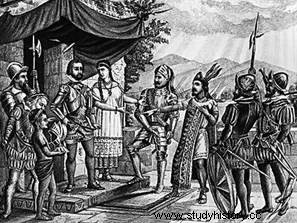 The pre-Columbian civilization of the Aztecs dominated most of Mexico until the arrival of the Spanish. With the successive extensions of the territory, the submission of the lands and growing prosperity, the Empire was at its peak. Cortés himself was fascinated by the beauty of the capital, which he describes as the new Venice “There are temples or houses of idols of very beautiful architecture in this great city […] Among these temples , there is one, the principal of which no human tongue could speak the grandeur and the beauty.” However, the indignation provoked by the sacrifices served as justification for the Spanish conquest and evangelization forced.
The pre-Columbian civilization of the Aztecs dominated most of Mexico until the arrival of the Spanish. With the successive extensions of the territory, the submission of the lands and growing prosperity, the Empire was at its peak. Cortés himself was fascinated by the beauty of the capital, which he describes as the new Venice “There are temples or houses of idols of very beautiful architecture in this great city […] Among these temples , there is one, the principal of which no human tongue could speak the grandeur and the beauty.” However, the indignation provoked by the sacrifices served as justification for the Spanish conquest and evangelization forced.
Today, in Mexico, the last Aztecs, about a million people, live in a minority and are lost in the mass of mestizo populations. They have retained the Aztec-Nahuatl language, and their religion is a mixture of Aztec tradition and Catholicism. They claim the recognition of their people as well as the restitution of certain pieces including the feather crown presented like that of Moctezuma and exhibited at the Museum of Ethnology in Vienna.
Bibliography
- From Jacques Soustelle, The Aztecs:On the Eve of the Spanish Conquest. Hachette, 2008.
- From Jacques Soustelle, The Aztecs. PuF, 2003.
- Aztecs and Incas:Rise and Fall of Two Fabulous Empires by William-H Prescott. Pygmalion, 2007.
